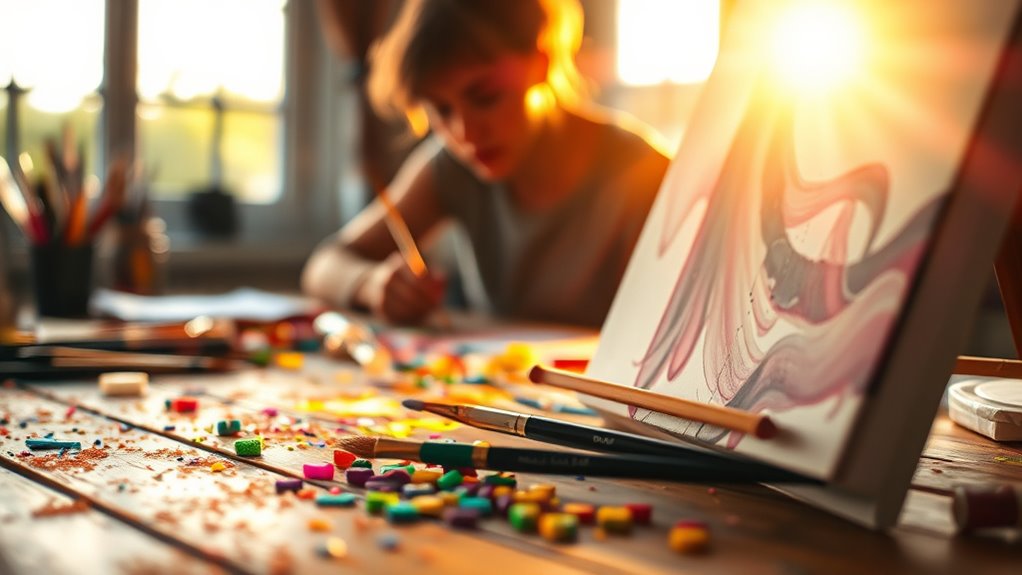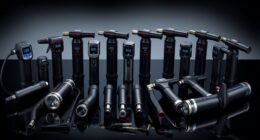Flow states in creative work occur when you achieve deep focus and immersion, making time seem to distort and boosting your productivity and creativity. You can access these states by practicing mindfulness techniques like focused breathing and meditation, which help reduce distractions. Developing your skills through consistent effort keeps tasks stimulating and prevents boredom. When you combine mindfulness with skill-building, flow becomes more natural and sustainable—exploring these strategies can unleash even greater creative potential.
Key Takeaways
- Flow states occur when skills match task difficulty, creating deep focus and immersion in creative work.
- Mindfulness techniques reduce distractions, helping individuals enter and sustain flow states more easily.
- Consistent skill development enhances confidence and engagement, facilitating more frequent flow experiences.
- The synergy of mindfulness and skill growth optimizes mental environments for spontaneous creativity.
- Achieving flow boosts productivity, creativity, and transforms work into an immersive, satisfying process.

Flow states, often described as being “in the zone,” are essential for unleashing peak creativity and productivity. When you enter this mental state, your focus sharpens, and time seems to distort as you become fully immersed in your work. Achieving flow isn’t accidental; it’s a skill that can be cultivated through specific mindfulness techniques and deliberate skill development. By understanding the science behind flow, you can harness it more consistently and elevate your creative output.
Flow states boost creativity and focus, turning work into a fully immersive, time-distorting experience.
Mindfulness techniques serve as powerful tools to help you access flow states. These practices train your mind to stay present, reducing distractions and mental clutter that often hinder deep work. Simple actions like focused breathing, body scans, or meditation can quiet the noise that pulls you away from your task. When you practice mindfulness regularly, you strengthen your ability to maintain concentration for extended periods, making it easier to slip into flow. It’s about creating a mental environment where your attention naturally gravitates toward your creative activity without interruption or resistance.
Skill development plays a pivotal role in entering flow states. As you improve your abilities through consistent practice, the tasks you undertake become more manageable, less frustrating, and more engaging. This mastery reduces anxiety and increases confidence, which are key factors for staying in the zone. The challenge lies in balancing difficulty with your skill level; if a task is too hard, frustration arises, but if it’s too easy, boredom sets in. Striking this balance keeps you motivated and pushes you toward flow. Developing your skills also involves setting clear goals and receiving feedback, which guides your progress and provides a sense of achievement that fuels ongoing engagement.
Combining mindfulness techniques with ongoing skill development creates a powerful synergy. When you’re mindful, you’re better equipped to recognize the onset of distraction or frustration, allowing you to gently steer yourself back into focus. Improving your skills ensures that your work remains stimulating and within your reach, preventing stagnation or boredom. Over time, this blend fosters a mental environment where flow states become more frequent and sustainable. As a result, your creative work becomes more spontaneous, innovative, and fulfilling.
Ultimately, mastering the science of flow involves intentional practice. By integrating mindfulness techniques into your routine and dedicating yourself to skill development, you set the stage for those powerful moments of deep focus. These moments not only enhance your productivity but also unlock new levels of creativity, transforming how you approach your work. You have the tools—now it’s about applying them consistently so that flow becomes a natural part of your creative process. Understanding the science behind flow states can help you develop more effective strategies to enter and sustain this optimal mental state.
Frequently Asked Questions
Can Anyone Learn to Enter Flow States Consistently?
Yes, you can learn to enter flow states consistently. By practicing mindfulness training, you become more aware of your focus and emotions, which helps you stay engaged. Skill development also plays a key role—improving your abilities makes challenges feel manageable and keeps you motivated. With dedication, these strategies help you cultivate the habits necessary to access flow states more often, enhancing your creativity and productivity over time.
How Long Does It Typically Take to Achieve Flow During Work?
You might find that achieving flow during work varies depending on task duration and your focus. Typically, flow onset can take anywhere from a few minutes to half an hour, especially when your task aligns well with your skill level. As you become more familiar with your work rhythm, you’ll notice flow arrives quicker, making your creative process smoother and more immersive over time.
Are There Specific Environments That Enhance Flow Experiences?
You can enhance your flow experiences by creating environments with the right ambient noise and physical comfort. Find a space where ambient sounds, like gentle background noise, help you concentrate without distraction. Guarantee your workspace is physically comfortable, with ergonomic furniture and proper lighting. When your environment supports relaxation and focus, you’re more likely to enter and sustain a state of flow, boosting your creativity and productivity.
How Does Flow Impact Long-Term Creativity and Innovation?
Flow boosts your long-term creativity and innovation by strengthening neuroplasticity research, which shows your brain’s ability to adapt and grow. When you regularly experience flow, you build creative confidence, making it easier to tackle new challenges and generate ideas. This continuous cycle enhances your skills over time, fueling ongoing innovation. Embracing flow helps you develop a mindset that nurtures sustained creative growth and resilience.
Can Technology Aid in Inducing or Maintaining Flow States?
Irony strikes—you can’t just switch on a flow state with a tap, yet tech seems to promise otherwise. Neuroscience insights suggest that tools like virtual reality can immerse you deeply, potentially triggering or maintaining flow. While technology offers immersive environments to focus, it’s no magic fix. You still need your own motivation and discipline, but with VR, you might just get a little closer to effortless creative flow.
Conclusion
As you gently embrace the flow state, you may find your creative energy quietly awakening, guiding your efforts with effortless grace. When you relax into this natural rhythm, productivity and inspiration become subtle companions on your journey. Remember, the best work often blooms in these quiet moments of harmony, where challenges become opportunities for growth. By nurturing this delicate balance, you open the door to a world of endless creative possibilities—where your true potential softly unfolds.









